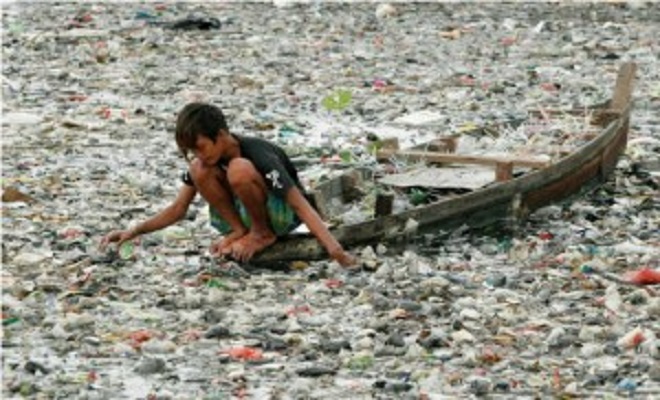 NEO.org
NEO.org
Geo Watch
Drowning in Garbage — Some Creative Solutions
by Janet Phelan, NEO.org:
Along with generally unstable governments and economic woes, the developing world has another, somewhat insidious problem: plastic pollution.
International corporations, seeking markets in developing countries, bring along with them a particular form of “baggage”—waste products and refuse. Coca Cola bottles, Frito bags, Twinkie wrappers—in large part, the packaging solution for multinationals is plastic. The developing world largely lacks the infrastructure in place to deal with this petrochemical polymer influx and plastic garbage has become a major environmental concern, with the impact felt world-wide.
Case in point is the Eastern Garbage Patch, so dubbed by oceanographer Curtis Ebbesmeyer. This patch of marine debris inhabits the Pacific Ocean and consists of small pieces of plastic, some floating and some suspended beneath the surface of the ocean. Estimates of the size of the patch range from 270,000 square miles to 5,800,000 square miles—or twice the size of the continental US.
The garbage patch is thought to have developed due to a gradual accumulation of plastic refuse and was formed over a period of time as a result of the oceanic gyre’s rotational pattern.
The effects on marine wildlife and by extension, all mammals which eat marine wildlife, is of grave concern. Jellyfish are known to indiscriminately consume plastic, and then are eaten by larger fish, which then may be consumed by humans. Endocrine systems may misread plastic as estradiol, resulting in hormone disruption, as well as other known toxic effects.
Plastic consumption often kills fish, birds and turtles.
Following the discovery of the Pacific Garbage Patch in the late nineties, at least four other similar gyres of garbage have been located, including in the Atlantic, Indian Ocean and elsewhere.
While international efforts have been launched to clean up the garbage patches, it is generally acknowledged that the problem of plastic garbage will have to be addressed at its source. According to Boylan Slat, who has developed a plan for cleaning up the marine garbage patches, any effort at ocean clean up would have to be paired with “radical plastic pollution prevention methods in order to succeed.”
Projects have been launched to take the garbage choking the third world and to transform it into useful products.
Environmental artist and designer Josh Roederer is trying to redefine our concept of what constitutes garbage. Roederer, who is based in Latin America and makes art as well as prosthetic legs and hospital beds out of plastic refuse, says:
“Garbage is one of those subjective words. For example –what is a weed? Dandelions are weeds, but they used to be useful. People would put them in salads and they had medicinal purposes. Garbage is just a word that says: I don’t want that anymore.”
Says Roederer, “For me, as an artist, it’s the idea of taking something that, say for instance a plastic bottle…it seems a shame to take something that has so much effort put into it—drilling the oil, processing it—and then throwing it away. For me it is similar to the romantic concept we have of the Native American, of using everything.”
In Guatemala, Long Way Home is constructing buildings out of plastic bottles and used tires. Founded in 2005 by former Peace Corps worker Matt “Mateo” Paneitz, LWH is currently constructing a school in Comalapa, Guatemala, which will house primary to secondary school students at its projected completion in 2016. The first phase of the school was completed in 2012, when the school accepted its first 21 students in grades 2-5. In 2013 the project received the official approval from the Ministry of Education. LWH now reports 91 students in grades K-7 for the 2015 academic year.
LWH reports: “Reused, rammed-earth tires form the walls of the school building, rainwater harvesting cisterns and retaining walls. Reused glass bottles become skylights, and trash bottle fillers line the roof and seams between the tires.”
According to LWH, the school “will provide a venue for young Comalapans to learns such trades as masonry and carpentry….Environmental education will be a focus of the school’s enhanced curriculum. From organic gardening too environmentally friendly construction methods, local youth will be learning about the inextricable link between environmental health and physical well being.
“Using environmentally friendly construction methods with materials such as trash bottles and tires, the school is a practical demonstration of ways to re-purpose discarded materials.”
Other enterprises are also looking at plastic as a viable building material. ByFusion Technology It has developed a hand operated press that turns plastic waste into building blocks. The inventor, Harvey Lacey, states “this block can be produced in developing regions under the worst circumstances. In other words, it can work anywhere there’s sufficient plastic waste. “
Says Lacey, “I see a solution to two problems facing us today. Plastic pollution is a worldwide issue. Another worldwide issue is affordable shelter. This block addresses both of those issues. It takes trash plastic and makes it into an affordable alternative building material.”
The Rag Bag is the brainchild of Siem Haffmans, who founded the company in 2005, after visiting Delhi for a conference on sustainable design. At the conference, he met an Indian woman named Anita Ahuja, who was already working with plastics, and had developed a method for pressing waste bags into sheets of colorful plastic. Under Haffman’s tutelage, Rag Bag began producing designer bags, made from the recycled plastic sheets. The company subsequently expanded and is now also producing wallets and organizers, all with a definite Indian flair.
In the midst of this upsurge of creative interest in reusing plastic, detractors remain. Some of the stated concerns about the ecologicalimpact of garbage have been met with a dispassionate dollars and cents response, which largely ignores the toxic effect of garbage. In a 2002 article for The Heartland Institute, Jerry Taylor, director of natural resource studies at the Cato Institute, wrote, “If it costs X to deliver newly manufactured plastic to the market, for example, but it costs 10X to deliver reused plastic to the market, we can conclude the resources required to recycle plastic are 10 times more scarce than the resources required to make plastic from scratch. And because recycling is supposed to be about the conservation of resources, mandating recycling under those circumstances will do more harm than good.”
Parenthetically, certain types of transnational waste dumping is prohibited by the Basel Convention. Accordingly, member countries are not allowed to use other countries as receptacles for certain types of hazardous waste. The US has not ratified the Basel Convention.
In the meantime, while the bean counters argue about the cost effectiveness of plastic recycling, one artist, Maria Christina Finucci has promoted the foundation of a Garbage Patch State. If the garbage patches remain unaddressed for much longer, we might be seeing the announcement of the creation a new land mass. Planet Plastica comes to mind….
Read More @ NEO.org












